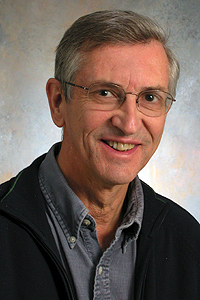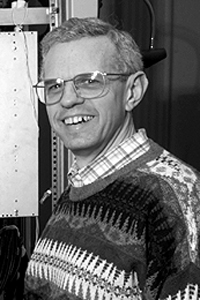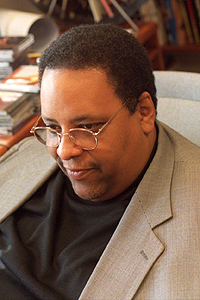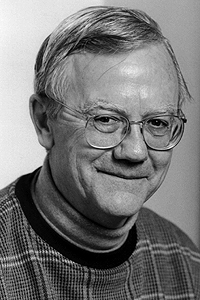National academies elect five University professors to their 2006 memberships
Two University faculty members, Francisco Bezanilla, Professor and Pritzker Scholar in Pediatrics and the Institute for Molecular Pediatric Science, and Melvyn Shochet, the Elaine M. & Samuel D. Kersten Jr. Distinguished Service Professor in Physics, the Enrico Fermi Institute and the College, were among 72 individuals elected to the National Academy of Sciences on Tuesday, April 25. Election to the 143-year-old academy is considered one of the highest honors that can be awarded to an American scientist. The election of Bezanilla and Shochet brings to 41 the current number of Chicago faculty elected to membership.
In addition to the NAS election, the American Academy of Arts and Sciences elected three University scholars to its membership on Monday, April 24. Those faculty members are: Michael Dawson, the John D. MacArthur Distinguished Service Professor in Political Science and the College, Reid Hastie, Professor of Behavioral Science in the Graduate School of Business, and Michael Murrin, the David B. & Clara E. Stern Professor in the Humanities. They are among 175 new fellows and 20 new foreign honorary members.
Also elected to the American Academy of Arts and Sciences this year is Fred Kavli, the founder of the Kavli Foundation of Santa Barbara, Calif., which donated $7.5 million to the University in 2004, to make permanent the Center for Cosmological Physics.
The current membership includes 170 Nobel laureates and 50 Pulitzer Prize winners. An independent policy research center, the American Academy of Arts and Sciences undertakes studies of complex and emerging problems. Current research focuses on science and global security; social policy; the humanities and culture; and education. Bezanilla studies the biophysics of excitation—how voltage-dependent ion channels regulate the generation and propagation of nerve impulses in excitable cells.
 Francisco Bezanilla | |
Ion channels, found in every cell in the body, are tightly controlled tunnels through the cell membrane that allow small charged particles such as potassium, sodium and calcium ions—key regulators of many fundamental processes in biology—to flow in and out of the cell.
Bezanilla’s work focuses on how cells monitor and regulate ion flow through these channels. By manipulating the channel protein with molecular biological techniques, and using electrical and optical techniques to monitor structural changes, he has been a pioneer in the effort to understand channel function at the molecular level, which is expected to lead to the development of many new medications.
A native of Chile, Bezanilla earned his B.S. in biology and his M.S. and Ph.D. in biophysics from Catholic University in Santiago. He came to the United States in 1969 as a post-doctoral fellow in biophysics at the National Institutes of Health, followed by a second fellowship in physiology at the University of Rochester.
He joined the faculty at the University of Chile in 1972. In 1977, he was appointed Professor of Neuroscience at the University of California, Los Angeles. The recipient of many awards in his field, including election to the Latin American Academy of Sciences, Bezanilla joined the Chicago faculty this year.
Shochet is a member of the Collider Detector at Fermilab collaboration, in which scientists study high-energy collisions of subatomic particles with the world’s most powerful particle accelerator.
In April, the CDF collaboration made news when it announced the precision measurement of extremely rapid transitions between matter and antimatter, which occur three trillion times per second. The discovery was a crucial step toward a better understanding of the early universe and how the world as it exists today came to be.
 Melvyn Shochet | |
Shochet co-led the Chicago team that helped build two critical components of the upgraded CDF experiment, which began in 2001. He served as scientific co-spokesman for the 439-member CDF collaboration, which obtained the first direct experimental evidence for the top quark in 1994.
Shochet also is a member of the ATLAS collaboration at CERN, the European particle physics laboratory. The ATLAS experiment will begin when construction is complete on CERN’s Large Hadron Collider in 2007. Between 2001 and 2002, he was a member of a Department of Energy-National Science Foundation committee charged with developing a 20-year plan for the future of high-energy physics.
Shochet was elected to the American Academy of Arts and Sciences in 2005. He received his Ph.D. from Princeton University in 1972. That same year, Shochet came to the University as a research associate and then joined the faculty in 1973. He was recently appointed Chair of the High Energy Physics Advisory Committee, which advises the U.S. Department of Energy and the National Science Foundation on the current and future program in elementary particle physics.
In 1863, Congress established the National Academy of Sciences, a private organization of scientists and engineers that serves as an official advisory body to the federal government in matters of science and technology.
Dawson is a leading expert in African-American political attitudes.
His most recent project, the 2005 Racial Attitudes and the Katrina Disaster Study, is one of the first to analyze racial differences in reactions to the reporting of the tragedy and people’s attitudes toward the responsibilities of the victims to avoid the disaster.
 Michael Dawson | |
The study, being conducted with Cathy Cohen, Professor in Political Science and the College, and Melissa Harris-Lacewell, Assistant Professor in Political Science and the College, shows that sharp racial gaps between blacks and whites are undermining the process of deciding how to rebuild New Orleans.
Dawson is the founding director of the Center for the Study of Race, Politics and Culture. He was co-principal investigator of the 1988 National Black Election Study and was principal investigator of the 1993-1994 National Black Politics Study, which he and Ronald Brown conducted.
Dawson also led the Black Civil Society Study, and with Lawrence Bobo, Dawson conducted seven public opinion studies on the racial divide in the United States. The information the two scholars gathered between 2000 and 2005 is considered the richest data on this issue that exists. They currently are working on a book that will detail their analysis of this data.
Dawson is the author of Black Visions: The Roots of Contemporary African-American Political Ideologies, published in 2001. His book, Behind the Mule: Race and Class in African-American Politics, was published in 1994.
Dawson received a B.A. in 1982 from the University of California, Berkeley, and a Ph.D. in 1986 from Harvard University.
Hastie teaches courses on Managerial Decision Making as well as Groups, Teams and Leadership. Prior to joining the GSB in 2001, Hastie taught at Harvard University, Northwestern University and the University of Colorado, where he also was Director of the Center for Research on Judgment and Policy.
His primary research interests are in the areas of judgment and decision-making (managerial, legal, medical, engineering, and memory and cognition), and social psychology. He has published more than 100 articles in scientific journals on these topics. He is co-author, with Robyn Dawes, of the textbook Rational Choice in an Uncertain World: The Psychology of Judgment and Decision Making.
 Reid Hastie | |
Hastie is currently studying the psychology of investment decisions; the role of explanations in category concept representations (including the effects on category classification, deductive and inductive inferences); civil jury decision making (punitive damages and sexual harassment); the primitive sources of confidence and probability judgments; decision making competencies across the adult life span; and neural substrates of risky decisions.
He has served on review panels for the National Science Foundation, the National Institutes for Health, the National Research Council and on 16 professional journal editorial boards.
Hastie earned a B.S. in psychology from Stanford University, an M.A. in psychology from the University of California, San Diego, and a Ph.D. in psychology from Yale University.
Murrin teaches in the departments of English Language & Literature and Comparative Literature, as well as the Divinity School and the College.
His research interests lie in two areas: the history of criticism, with a specialty in the history of allegorical interpretation, and the study of the genres of romance and epic. His teaching focuses on period courses in the late Middle Ages, the Renaissance and the early modern period.
 Michael Murrin | |
The author of The Veil of Allegory, The Allegorical Epic and History and Warfare in Renaissance Epic, Murrin is currently working on Romance and Asian Trade in Late Medieval and Early Modern Europe. His latest project intertwines themes of the growth of Europe’s middle-class culture and interest in aristocratic romance, as well as the simultaneous development of merchant trade across Asia, initially made possible by the Mongol world system. The book is a study of the imagination and attitudes that Murrin says affect thinking about Asia to this day.
After serving for two years as an instructor, Murrin joined the University faculty as an Assistant Professor in 1965. He has received two short-term fellowships for his research, one from the Huntington Library in 1996, and another from the Folger Library in 1997. He was presented with a Guggenheim Foundation award in 1974, and he earned the University’s Llewellyn John and Harriet Manchester Quantrell Award for Excellence in Undergraduate Teaching in 1967.
A graduate of Yale University, Murrin earned his M.A. in 1961 and his Ph.D. in 1965. He completed his B.A. in 1960 at the College of St. Thomas in St. Paul, Minn.
Kavli, a Norwegian-born physicist, founded the Kavli Foundation in 2000 to advance science for the benefit of humanity and to promote increased public understanding and support for scientists and their work. Kavli and the foundation support 10 research institutes worldwide, including Chicago. More than 70 scientists and students at the renamed Kavli Institute for Cosmological Physics carry out research that fuses cosmology with particle physics.
Founded in 1780 by John Adams, James Bowdoin, John Hancock and other scholar-patriots, the academy has elected some of the most influential thinkers and leaders from each generation, including George Washington and Benjamin Franklin in the 18th century; Daniel Webster and Ralph Waldo Emerson in the 19th century; and Albert Einstein and Winston Churchill in the 20th century.
![[Chronicle]](/images/sidebar_header_oct06.gif)